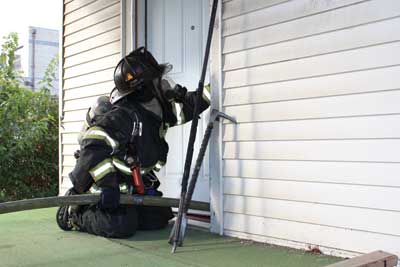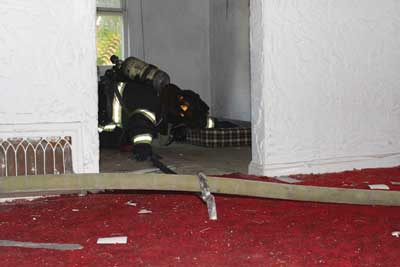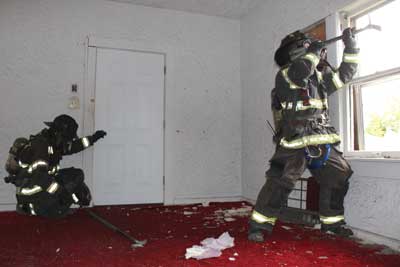By Scott Kleinschmidt
Much research has been done over the past few years on fire behavior in modern furnished dwellings. Studies have emphasized the importance of fast water application, coordinated ventilation, and a heightened awareness regarding flow paths. This article examines a few modifications that you can make to your bread-and-butter operations using some of the applicable lessons from the studies to achieve your primary mission. With simple adjustments, you can ensure life safety with aggressive and successful search in a private dwelling fire while minimizing fire growth and still making a push toward extinguishment.
Fire attack and search
In most departments, especially those with limited staffing or delayed second-due companies, the company most likely to find a victim in the primary egress route is fire attack. Although these personnel’s principal purpose is to execute a rapid stretch to get water on the seat of the fire, they are still responsible for basic search responsibilities. The backup or door position is best situated to accomplish this task when advancing up the line. When moving up to rejoin their crew, they can account for the immediate area on both sides of the stretch, sweep along the egress for adjacent openings (i.e., bedrooms and bathrooms), and isolate these rooms until a traditional search can take place.
Take for instance an engine company that arrives first due staffed with four. The chauffer assumes pump operations, leaving only three members to do the job of many. The door position gets the door and essentially starts the search. Since this position comes off the rig unmasked, it is important to conduct a comprehensive size-up of conditions to determine the appropriate level of protection before the member takes the door. The door firefighter in my department carries a six-foot New York roof hook and a set of irons in a way that leaves him with a free hand to check doors and assist with the stretch as needed.
After the door firefighter forces the entrance, he is responsible for sounding the floor, sweeping the approximate area near the egress including behind the door, getting a snapshot of the footprint, and controlling this ventilation point until the line is ready to initiate an advance. Unless the fire has self-vented, the entry point can become the primary ventilation flow path. This can draw smoke and fire if left uncontrolled. An additional consideration is to open a small hole overhead to check for fire.
In a perfect world, this all takes place while the company officer performs a quick 360º walk-around. When appropriate and conducive to fire conditions, the company officer may decide to horizontally vent the fire room prior to entry. Timing and location of the vent are directly linked to the fire and smoke conditions. Before the window is taken, communicate the following to the door position: Ingress has been forced, it is being controlled, the line is flaked out and properly bled off, and the attack crew is ready to make an interior push. After an adequate ventilation opening is established, the officer will rejoin the crew to initiate a timely attack. During the advance, the door firefighter is accountable for minimizing the flow path back toward the entry until the fire has been knocked down (photo 1).
 |
| (1) The doorman controls the entry point while feeding line to the attack crew. (Photos by Samuel Hittle.) |
With the line in place, the door firefighter slides up the line, chasing kinks and conducting a modified search. The nozzle firefighter and company officer have already covered this ground on their way to the fire room but have done so quickly. Unless they directly encounter a victim, they could easily miss someone just a few feet off their path. To ensure not overlooking possible victims and to identify openings, the door firefighter must get as wide as possible in his search pattern while maintaining contact with the hose.
Although the primary reason for the roof hook is to open ceilings and walls, this particular tool works great when tethered to the hose. The extended reach augments the ability to clear areas deep into an opening without overextending the firefighter.
After clearing an opening, the firefighter shuts the door to isolate the room until a more thorough search can be completed (photo 2). This will help eliminate smoke flow paths, which is a major concern for occupants inside. Should the fire get away from you, closing the door also protects against thermal insult and ultimately increases property conservation.
 |
| (2) The doorman uses the six-foot hook to safely search a room adjacent to the direction of the line on his way to the fire room. |
TRADITIONAL SEARCH
If you arrive as the first-due truck or second-due engine, assuming the attack line is doing okay, search becomes the next assigned priority. For most departments, a traditional search is preferred unless there is a confirmed victim and location, indicating a vent-enter-search (VES) operation. Other departments are comfortable with splitting the truck into inside/outside teams, with the outside team executing VES as one of its many functions. Regardless of the deployment model, you must conduct a conventional primary search. Start the traditional search near the fire, removing the most endangered people first and working back. If additional victims are in the house, initial isolation tactics performed by fire attack buy them some time.
The inside search team can replicate the same proven tactics that make VES operations safe and efficient. When conditions warrant, the following will enhance a rapid primary search. The officer or lead will identify the area to be searched; direct and monitor a search firefighter with a thermal imaging camera, checking behind the door; and prepare to isolate the box while monitoring the egress. The search firefighter quickly crosses the room and locates a window to vent. When he finds one, he announces, “Window.” This signals the officer to move into the room and close the door. With the door shut and the room isolated, the officer announces, “Take it” (photo 3).
 |
| (3) The search team firefighter takes the glass to aid in the search of an interior room while the doorman maintains control of the door and scans the room with a thermal imaging camera. |
This procedure compartmentalizes the room, giving trapped smoke a much-needed exhaust and aiding the search. With smoke conditions improving, you can finish clearing the unsearched real estate. Should you find a victim, you can consider a window removal. Often in a traditional search, it is habit to remove a victim by our original route. This further exposes the victim to the smoke and products of combustion during the removal process. Even if a ladder and outside assistance are needed when operating from an elevated floor, everyone is far better off because the area has been compartmentalized. If you do not find a victim, leave the room and continue on with the search, closing the door behind you. Note: Be cautious when searching above the fire. Leaving the glass in place will reduce the potential for autoexposure.
Using the above tactics when appropriate, in conjunction with an outside vent position/team covering the rear, secondary egress points, and targeting high-value areas for VES, can help you systematically and quickly clear the structure of any trapped victims. This is the primary reason you are there.
SCOTT KLEINSCHMIDT is an 18-year veteran of and a lieutenant with Wichita (KS) Fire Department Truck 2. He spent most of his career assigned to the rescue company. He is a member of the city/county technical rescue team and a rescue technician/manager with KS-TF5 USAR team. He is a department coordinator/trainer in truck company operations and an adjunct instructor in the training division. He lectures and provides hands-on training in reduced staffed fireground operations, truck company operations, and all disciplines of technical rescue operations.
Fire Engineering Archives

